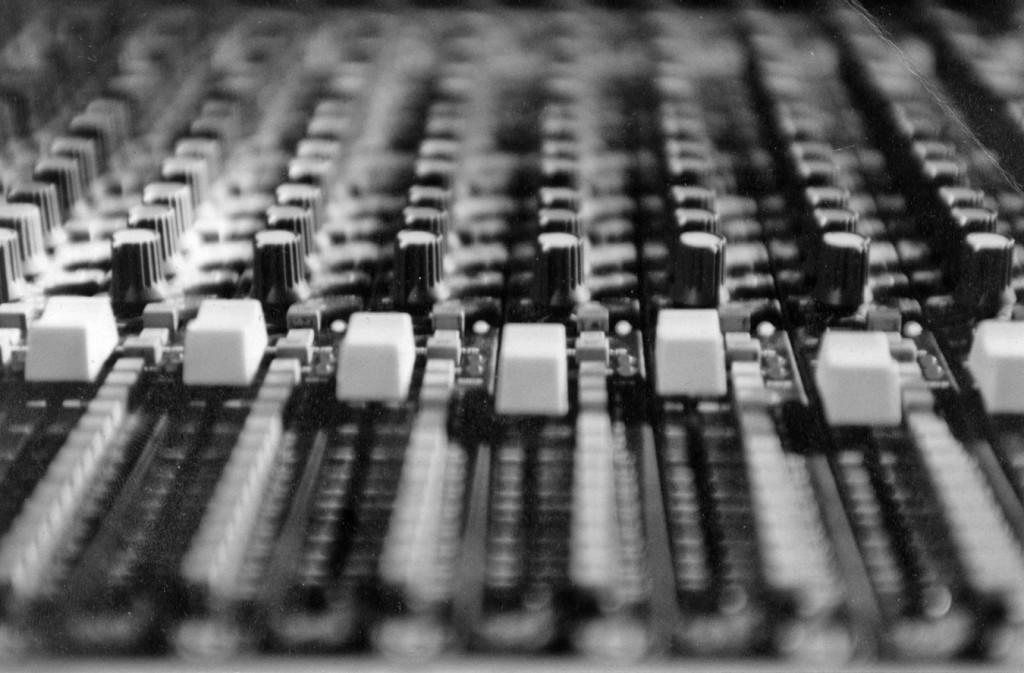
Less Mud and Drum Panning Tips
Placing different instruments in their own locations in the stereo field is what engineers use to help make a mix less muddy. Many recording engineers pan tracks to mimic a live group as you would see them on stage. As we usually start with the drums when we begin mixing, here is how we often pan drums: starting with the stereo overhead drum mics, we usually pan them hard left and right. Then we listen to this stereo mix of the drums solo-ed and start to “place” the individual close mic’d drums to match. So for instance, with the stereo overhead tracks playing, we’ll hear that the hi-hat is at 1 o’clock and so that’s where we’ll pan the closed mic’d hi-hat track. Now bringing the hi-hat track into the mix, we’ll make minor adjustments to the panning until it sits correctly in that stereo space. We’ll repeat this process for each individual drum track until everything matches the overheads. You can also pan from the musician’s perspective, which would obviously mean that everything is flipped – our hi-hat would now be panned to 11 o’clock instead of 1 o’clock.
Guitars to 11
In rock music we almost always want guitars to be loud in the mix (at least guitarists do). And if you give a rock guitarist a loud place in the mix, you can be sure that the lead vocalist will want a loud place too. So what are we to do? How can both the vocals and guitars be loud at the same time? You guessed it – panning to the rescue. Instruments like guitars take up a lot of the sonic spectrum, they can easily over take other tracks like vocals; panning can help to keep them from overwhelming a mix. Try this: take that big guitar track that’s crowding everything else out and pan it hard left. Okay, now the vocals have their space but the guitar is lost over on the left – sounds weird, huh? We need a second guitar track panned hard right to balance it out. Studio trick: have the guitarist record a second rhythm part, mimicking the first and pan this track opposite the first track. You now have all the energy but with a hole in the middle of the mix for the vocals, etc.
Let’s Move In Together
We can also place different instruments in the same location to enhance the feeling that there is one instrument creating a more complex sound. For instance, most rock/pop mixes have the kick drum and bass guitar panned center so that these two high-energy instruments seem to be one and the same. Vocal backups are another example where often a doubled vocal part or another vocalist singing a similar melody to the lead, is placed in the same location in the mix so that to the listener it almost sounds like the lead singer has a deeper, more interesting delivery. So whenever you are trying to enhance a part, like let’s say you want an organ or electric piano to add oomph to a guitar part on certain hits, we suggest you pan these instruments together.
LCR
No, it’s not some kind of new high resolution TV – LCR stands for “Left, Center, Right” and it’s another panning philosophy that many mixing engineers employ to open up the soundstage and create a spaciousness that seems wider than life. It’s based on the idea of panning many instruments hard left and right in stereo pairs, kind of like we did with the guitars above, with some core instruments (vocals/kick/bass) panned center. To get stereo pairs of the same instrument, you either need 1) a performance played twice (like we did with the guitars in the earlier example) 2) a stereo output from an instrument – like a piano mic’d in stereo or a stereo output from a synth, or 3) a clone of a track to make an exact copy. With these stereo pairs, you can have fun putting certain effects only on one side of the pair – for example try inserting a timed delay on just the right of a stereo synth track. This approach can help keep the mix from getting muddy.
ABOUT THE AUTHORS
Zac Cataldo is a musician and owner/producer at Night Train Studios, a recording studio in Westford, MA. He is also co-owner of Black Cloud Productions, a music publishing company. Reach him at zac at nighttrainstudios.com.
Brent Godin is a bassist/guitarist and engineer/producer at Night Train Studios. He is also a talent scout at Black Cloud Productions. Reach him at brent at blackcloudproductions.com.